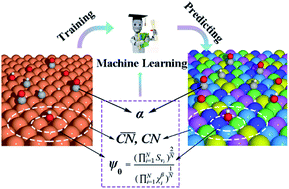A transferable machine-learning scheme from pure metals to alloys for predicting adsorption energies†
Abstract
Alloys present great potential in catalysis because of their adjustable compositions, structures and element distributions, which unfortunately also limit the fast screening of potential alloy catalysts. Machine learning methods are able to tackle multi-variable issues but still cannot predict complex alloy catalysts from the properties of pure metals due to the lack of universal descriptors. Herein we propose a transferable machine-learning model based on the intrinsic properties of substrates and adsorbates, which can predict the adsorption energies of single-atom alloys (SAAs), AB intermetallics (ABs) and high-entropy alloys (HEAs), simply by training the properties of transition metals (TMs). Furthermore, this model builds the structure–activity relationship of the adsorption energies of alloys from the perspective of machine learning, which reveals the role of the surface atoms' valence, electronegativity and coordination and the adsorbates' valence in determining adsorption energies. This transferable scheme advances the understanding of the adsorption mechanism on alloys and rapid design of alloy catalysts.



 Please wait while we load your content...
Please wait while we load your content...